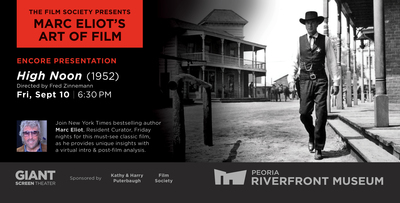

HIGH NOON
Fri, Sep 10 | 6:30 PM
Tickets | CLICK HERE
Fred Zinnemann’s High Noon (1952) was originally intended as a celebration of the World War II Allied victory against the fascists. Carl Foreman began writing the screenplay in 1945, shortly after he and his producing partner, Stanley Kramer, were discharged from the military.
By 1951, the partnership had ended, Foreman was suspected by the House Un-American Activities Committee (HUAC) of having once been a member of the communist party and the committee wanted him to take the stand and name names. Whereas Elia Kazan did testify and did name names and turned an informer into a hero in his On the Waterfront a few years later, in High Noon Foreman turned HUAC into the Frank Miller gangbent on killing the marshal (Gary Cooper) who stands in for Foreman himself.
Foreman’s script was hailed by some in Hollywood and vilified by others, including John Wayne, when he was offered the role of Marshall Kane. Wayne, (who never served in the military) called the film “Un-American” because the townspeople didn’t help the sheriff.
In Foreman’s revised script, the townspeople became the civilians captured by the Axis powers during WWII, the sheriff the American army not looking for a fight but not backing down from one either (speak softly and carry a big stick) his virginal wife (Grace Kelly, making her film debut) represents the hope for peace, Katy Jurado the profiteers who benefited from sleeping with the enemy and Lloyd Bridges’ deputy blind ambition seeking to capitalize on the chance to be a hero.
Most of the film takes place before it begins, and all the romantic entanglements are revealed in the 95 minutes of real time. Foreman conceived the device, including the ticking clocks, and the director of the film, Fred Zinnemann increased the building tension by using close-up and camera placement to both enlarge the stature of the bad guys and reduce that of the hero. High Noon was filmed by Floyd Crosby in high contrast to try to capture the stark black and white look of William Brady’s civil war photos (Crosby was the father of musician David Crosby).
By the time the film opened, Foreman received only onscreen writing credit; the film had no producer listed. He was in no position to argue; the Feds were looking to have him arrested on contempt charges for not testifying before the Committee. The night the film opened, Foreman was living in exile, in London, where he wrote Bridge on the River Kwai and several other screenplays under a pseudonym, while Grace Kelly was ending her affair with Cooper. The saintly Grace (how could Jimmy Stewart ever wish to kill her?) also had an intense affair with Clark Gable while they starred in John Ford’s 1953 Mogambo, with Ray Milland in Hitchcock’s 1954 Dial M for Murder, with Bing Crosby in George Seaton’s 1954 The Country Girl (for which she won a Best Actress Oscar), and wanted one with Cary Grant in To Catch a Thief, but, well, you know … and once again with Bing in Charles Walters’ 1956 High Society. She finally settled for a real-life prince and lived miserably ever after.
High Noon is ranked 27th in the AFI’s list of 100 greatest films of all time.
See you on the big screen!
Marc Eliot
Resident Film Curator